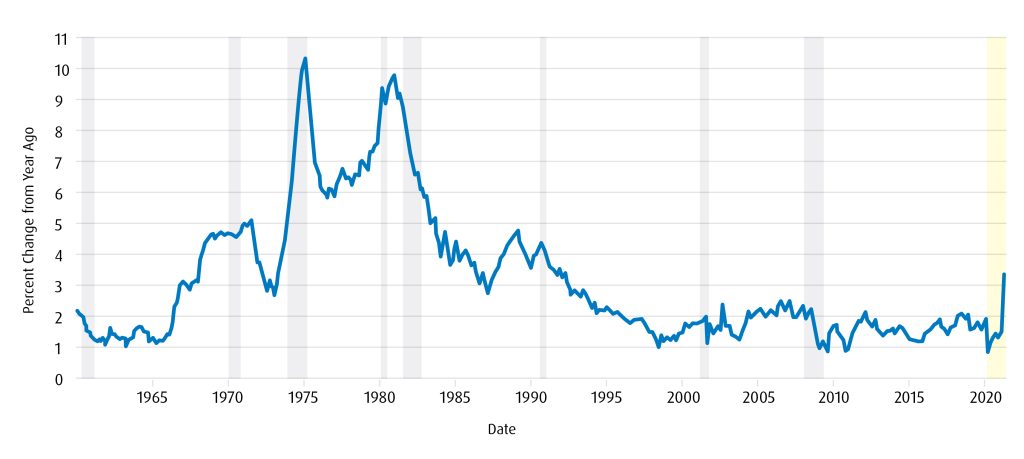With a new rate regime underway, Fred Demers, Director, Multi-Asset Solutions Team, digs into one of the core assumptions of all fixed income allocations—the 2% inflation target – while providing valuable historical context on it.
When paradigms shift, unquestioned truths from a previous era often come undone. One such example can be found in the fixed income universe, where interest rates recently rose from near zero percent—a historical low at which they hovered for more than a decade—to above 5% in a relatively short span. During this upheaval, a core assumption of monetary policy appeared to be under threat: the 2% inflation target.
Prevailing wisdom says the 2% threshold provides an optimal trade-off between price stability and economic growth. However, the past couple of years have shown that a remarkable surge in inflation, followed by an aggressive series of central bank rate hikes, can be compatible with positive economic growth. Having experienced two years of runaway inflation and nearly full employment, does the central banks’ model continue to make sense?
Origins of the 2% Inflation Target
Starting in the late 1970s, economic literature began to focus on the problem of anchoring inflation expectations. The post-WWII experience was of an excessively violent business cycle, and what made matters worse was that monetary policy had not evolved. Central banks were still relying on old fashioned monetary policy techniques to steer the economy. They added to or removed from the money supply at will, creating awkward incentives for commercial banks, which then learned to adapt into faster, wiser, and more cunning lenders of capital.
Personal Consumption Expenditures, Excluding Food and Energy (Chain-Type Price Index): January 1960–November 2023

Source: U.S. Bureau of Economic Analysis.
Some policymakers saw this as an opportunity. Led by U.S. Federal Reserve (the “Fed”) Chairman Paul Volcker, central bankers began to use interest rates—or rather, the cost of money—as a more powerful tool to control the business cycle. While this idea may seem banal and commonplace today, it was considered a radical “experiment” when the Fed aggressively pursued disinflation four decades ago. It worked and prices began to cool from Volcker’s relentless rate hikes, effectively proving that inflation could be contained through monetary policy. The next natural question was: if you are containing inflation, why not have a target?
Inflation: A Moving Target
Central banks prefer to keep the game simple—the higher the target range, the less likely they will run out of room to cut interest rates.
Ultimately, it would not be a major surprise if the Fed considered moving its target to 3% in order to permanently anchor inflation expectations higher. Both U.S. labour markets and GDP growth have demonstrated an impressive amount of resilience in the wake of pandemic-driven inflation, and in general, higher inflation targets tend to keep policymakers in the realm of traditional monetary theory. Central banks prefer to keep the game simple—the higher the target range, the less likely they will run out of room to cut interest rates and need to rely on unconventional tools, such as negative rates and quantitative easing.
The Expected Market Response
In our estimation, the market would—or perhaps should—interpret an upward revision to the inflation target as a positive signal. The move would indicate that the economy does not require the same degree of tightness, all else being equal, and demonstrate the Fed’s willingness to allow the economy to run hotter. It would also paint their earlier move toward average inflation targeting as a first step away from the zero lower bound.
It is worth remembering that all central banks desire a positively-sloped yield curve. It is viewed as measure of economic normalcy, yet the 2% limit means policymakers often have to put handcuffs on growth precisely when animal spirits are starting to take hold. This deliberate inversion of risk can be surprisingly damaging—it forces investors to sit in cash when they should be rewarded for taking on duration. It drives capital to become unproductive and lazy, and puts sand in the economic gears. What we should want instead is for capital to be chasing growth, taking measured chances, and financing the future.
One hesitation policymakers may have is that by shifting the target, they risk de-anchoring inflation expectations entirely. For example, the market could witness a move to 3% and immediately begin speculating about an increase to 4%. Losing control of the narrative in this manner poses significant risks for the Fed. Communication exercises are an essential part of the central banker’s toolkit, which is why the Fed will likely initiate a research agenda at the outset to explore potential consequences if it does pursue this shift.
Unlike their peers at the Fed, officials at the Bank of Canada are unlikely to pursue a change to their current inflation targeting. As covered by my colleague Brittany Baumann in Diverging Paths: Behind the U.S. and Canada’s Economic Schism, a recent split in the U.S. and Canadian economies reveals sharply different underlying strengths and weaknesses. Canada’s interest rate sensitivity, for instance, suggests its labour and housing markets are simply unable to withstand continual rate hikes as well as their American counterparts.
Whether or not inflation targets are altered, the fact remains that the next decade of interest rates is unlikely to mirror the one that preceded it. Institutional allocations have already changed accordingly during the past 12 to 18 months—cash offered a safe haven during the tightening; however, we appear to have reached the peak of the monetary cycle and risk-free assets do not offer optimal exposure to future rate cuts. A new dynamic is taking shape—one where institutional investors have a long runway for a full cycle to unfold.
Please contact your BMO Institutional Sales Partner to learn more.
Footnotes
1 St. Louis Federal Reserve, “Personal Consumption Expenditures Excluding Food and Energy (Chain-Type Price Index), last accessed January 4, 2023.” CFIF/BATVN, October. 16, 2023.↩
2 St. Louis Federal Reserve, “Lucy Craymer, “The mouse that roared: New Zealand and the world’s 2% inflation target,” Reuters, January 30, 2023.” CFIF/BATVN, October. 16, 2023.↩
3 U.S. Federal Reserve, “Review of Monetary Policy Strategy, Tools, and Communications,” last updated August 27, 2020. ↩
Not intended for distribution outside of Canada.
The viewpoints expressed by the Portfolio Manager represents their assessment of the markets at the time of publication. Those views are subject to change without notice at any time. The information provided herein does not constitute a solicitation of an offer to buy, or an offer to sell securities nor should the information be relied upon as investment advice. Past performance is no guarantee of future results. This communication is intended for informational purposes only.
Certain of the products and services offered under the brand name BMO Global Asset Management are designed specifically for various categories of investors in a number of different countries and regions and may not be available to all investors. Products and services are only offered to such investors in those countries and regions in accordance with applicable laws and regulations.
This communication is intended for informational purposes only and is not, and should not be construed as, investment, legal or tax advice to any individual. Particular investments and/or trading strategies should be evaluated relative to each individual’s circumstances. Individuals should seek the advice of professionals, as appropriate, regarding any particular investment. Past performance does not guarantee future results.
All figures and statements are as of month end unless otherwise indicated. Performance is calculated before the deduction of management fees. Past performance is no guarantee of future results.
The information provided herein does not constitute a solicitation of an offer to buy, or an offer to sell securities nor should the information be relied upon as investment advice. All investing involves risk, including the potential loss of principal. Past performance is not a guarantee of future results.
Certain statements included in this material constitute forward-looking statements, including, but not limited to, those identified by the expressions “expect”, “intend”, “will” and similar expressions. The forward-looking statements are not historical facts but reflect BMO AM’s current expectations regarding future results or events. These forward-looking statements are subject to a number of risks and uncertainties that could cause actual results or events to differ materially from current expectations. Although BMO AM believes that the assumptions inherent in the forward-looking statements are reasonable, forward-looking statements are not guarantees of future performance and, accordingly, readers are cautioned not to place undue reliance on such statements due to the inherent uncertainty therein. BMO AM undertakes no obligation to update publicly or otherwise revise any forward-looking statement or information whether as a result of new information, future events or other such factors which affect this information, except as required by law.
All Rights Reserved. The information contained herein: (1) is confidential and proprietary to BMO Asset Management Inc. (“BMO AM”); (2) may not be reproduced or distributed without the prior written consent of BMO AM; and (3) has been obtained from third party sources believed to be reliable but which have not been independently verified. BMO AM and its affiliates do not accept any responsibility for any loss or damage that results from this information.
BMO Global Asset Management is a brand name under which BMO Asset Management Inc. and BMO Investments Inc. operate.
®/™Registered trademarks/trademark of Bank of Montreal, used under licence.






